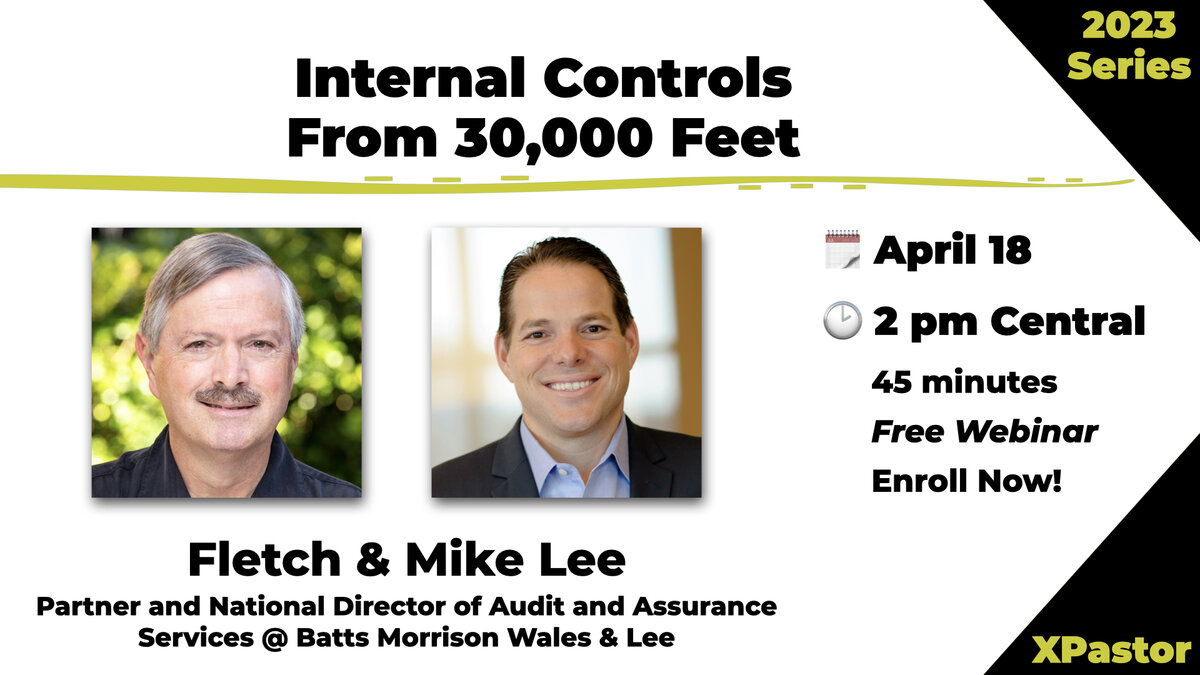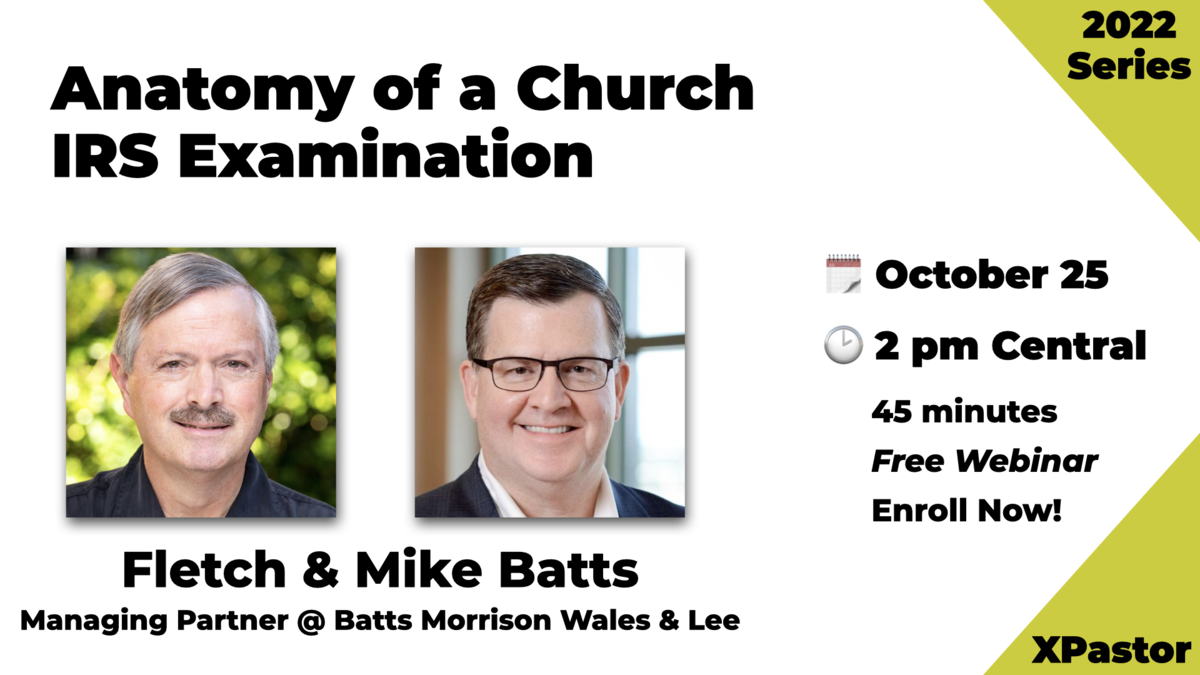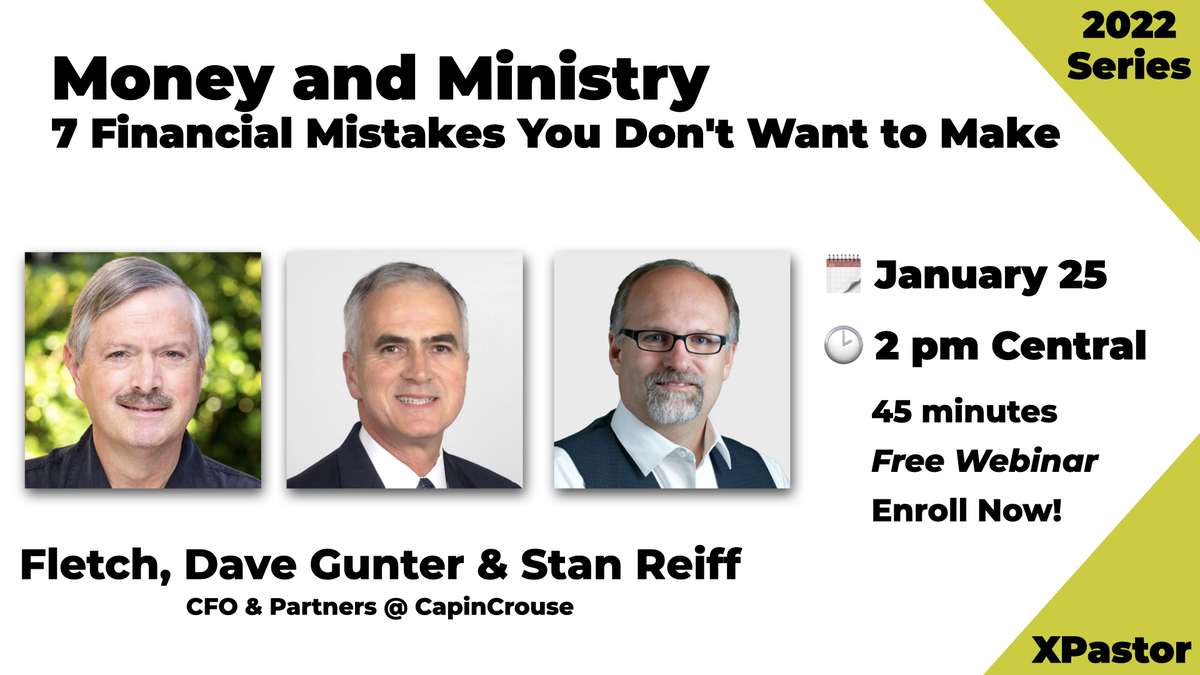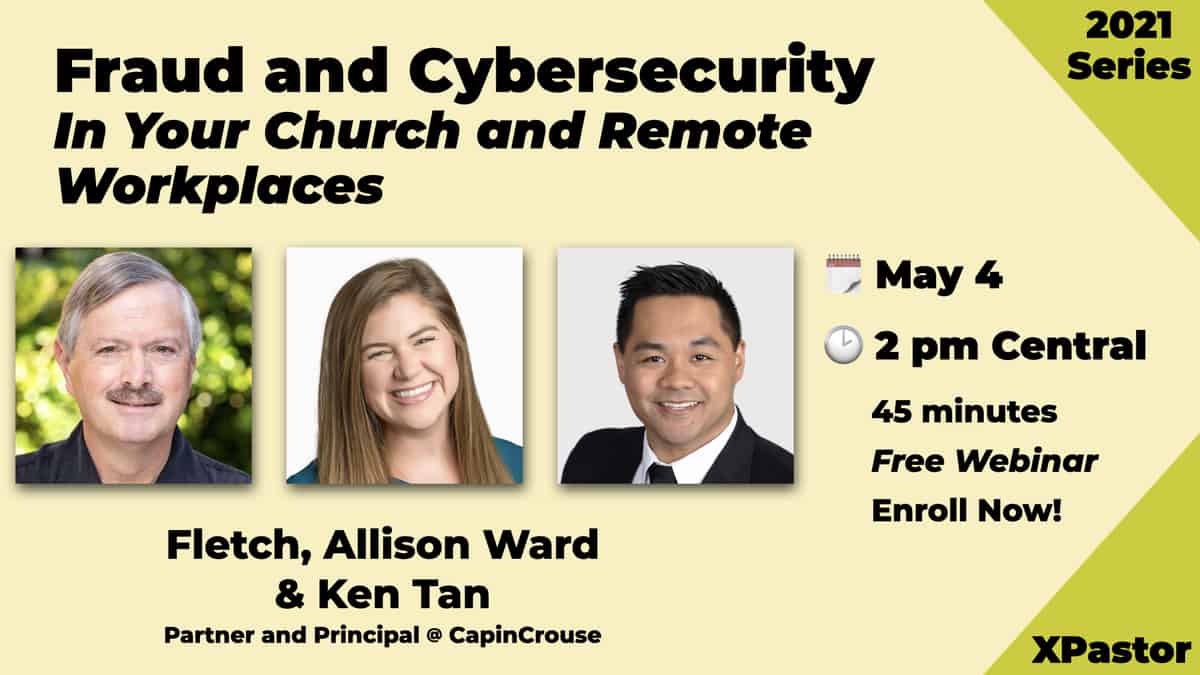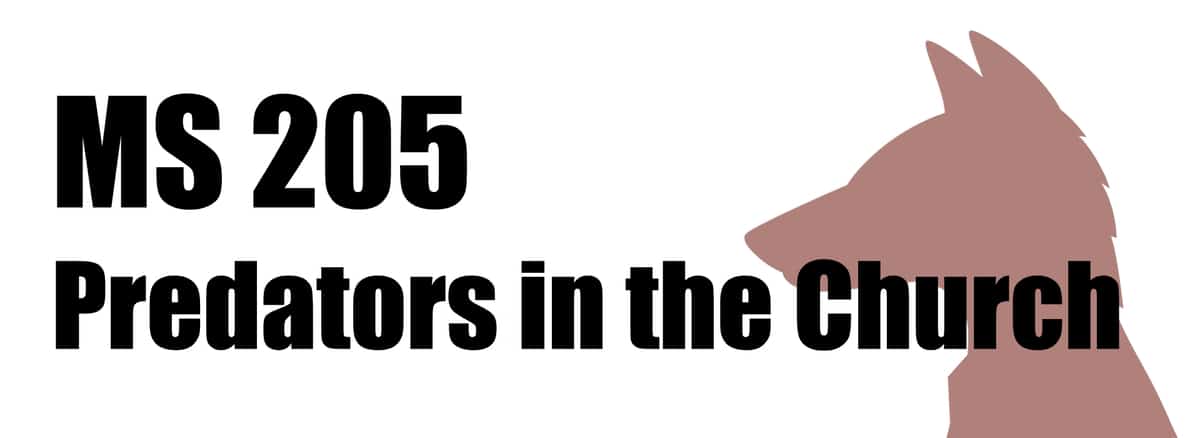We’ve all seen the tragic headlines about churches becoming the victims of fraud. To borrow some real-life examples: “Father and Son Pastors Plead Guilty to Stealing $3.1M from Church,” “Nebraska Archdiocese Sues Nun Accused of Stealing $820,000,” or “Over $1.3M for Church Planting Misused by Pastors.”
But as we read those headlines, it can be so tempting as XPs to think something like, “That’s awful news, but fraud like that could never happen in our church.” Unfortunately, it’s that very mindset that can leave our churches most vulnerable to becoming the next fraud victim or even the next sad news story.
I recently had the privilege at ECFA of hosting an informative conversation regarding church fraud with Rollie Dimos, a certified fraud examiner (CFE), and author of Integrity at Stake: Safeguarding Your Church from Financial Fraud. Drawing upon his expertise as a CFE and his wealth of experience as an internal auditor for over twenty-five years (most recently, Internal Auditor for the Assemblies of God denomination), Rollie shared with me and the rest of our listeners several important keys to protecting our churches from the Top 5 Fraud Schemes.
In this article, I would love to share with you some of the key takeaways from our conversation about how to stop fraud in its tracks so that your church is less likely one day to experience its painful consequences. But before we explore the Top 5 Fraud Schemes and how to prevent them at your church, let’s begin by laying a quick foundation in the form of a few important questions:
Why are churches and other nonprofits susceptible to fraud? Here we learn that some of our greatest strengths as a church can also be our greatest weaknesses when it comes to fraud. If you’re like most churches, one or all of these characteristics probably describe your operating environment: high levels of trust; close personal relationships; significant number of volunteers; low verification and background checks; the tendency to default to anyone who is willing to serve.
What is the impact of fraud? It might be hard to believe, but according to the latest report by the Association of Certified Fraud Examiners (ACFE), the typical organization loses 5% of its revenues in a given year as a result of fraud. To put it in perspective, that could be around half of your total giving toward missions and outreach if your church is committed to tithing (10%) of your giving to other partner organizations outside your local church. Admittedly, while churches may not be the “typical” organization profiled by ACFE with a 5% average loss in revenue to fraud, there’s no doubt the potential impact of fraud is still quite significant. A few other interesting facts from the same ACFE study: The median loss for all cases was $150,000; the median duration of fraud was eighteen months; and the presence of anti-fraud controls was correlated with both lower fraud losses and quicker detection.
Who commits fraud? In another study several years ago specifically examining fraud within the nonprofit sector, researchers found the typical persona of a fraud perpetrator to be an employee of the victim organization for at least three years, who earns under $50,000, and interestingly has no criminal record. Similarly, the ACFE study found that 95% of fraud perpetrators were first-time offenders with most (82%) having a clean employment history.
Why do people commit fraud? What a great question. We might suspect that the vast majority of people who choose to be employed by a church would be well-intentioned Christ-followers, and I’m sure that’s true. Only in an extremely rare situation would we see someone seek employment with a church specifically with the premeditated desire to cause harm to the church through fraud. So, how then do we explain all of those headlines and the more-than-rare occurrences of fraud?
To explain why people commit fraud, we have help from a classic illustration called the “Fraud Triangle” with its three main components: (1) Pressure, (2) Opportunity, and (3) Rationalization.
Pressure
First, for the typical person to commit fraud, he or she must be experiencing some sort of pressure. In many cases, that pressure would be financial or social (“Where will I get next month’s rent? “What will my friends think of me if I don’t have all of the same nice things?”) You could see how pressure might be especially higher at a church where wages tend to be more modest compared to other industries.
Opportunity
According to this second element of the fraud triangle, no one commits a crime thinking they will get caught. There must be a perception that they will be able to get away with the fraud, at least temporarily. And as we’ll explore later, weaknesses in our church’s internal controls can open the door of opportunity for fraud to occur.
Rationalization
Even with pressure and opportunity present, many people still won’t succumb to the temptation of fraud. But one way for their resolve to start weakening is through rationalization. In other words, the perpetrator starts giving into voices like “You work so hard and are underpaid at this church. You deserve more.” Or, maybe even something less egregious like “I’ll just borrow these funds for a few days to pay that bill and then give the money right back after my next paycheck.” Without this sort of rationalization, most fraudsters couldn’t sleep at night and carry on a normal life.
Pressure and rationalization are two elements of the fraud triangle that can be largely out of our church’s control; however, we can significantly cut down on the likelihood and impact of fraud by taking strategic action in the area of opportunity. These anti-fraud measures to combat fraud opportunities are commonly referred to as an organization’s system of “internal controls.”
So, as we cover the Top 5 Fraud Schemes below in more detail, think about the opportunities for each of them to occur in your church and pay attention to Rollie Dimos’ helpful fraud prevention tips.
At the same time, keep in mind it’s impossible to eliminate all possibilities of fraud in the church. As ECFA President Dan Busby explains, “The processes necessary to eliminate all fraud are nothing short of having a small army of employees rotating through different jobs as they separately review each transaction, with checks and balances that would bring any organization to a grinding halt. This would not be effective stewardship. Therefore, our goal should not be to eliminate all fraud but to find a reasonable balance between preventive efforts and risks.”
Expert Tips for Preventing the Top 5 Fraud Schemes
The latest ACFE report cites (1) Corruption, (2) Check Tampering, (3) Billing, (4) Expense Reimbursement, and (5) Skimming as the Top Five Fraud Schemes impacting the Religious, Charitable & Social Services Industry. Let’s walk through each of the schemes as defined by the ACFE and consider Rollie’s expert tips for reducing their opportunities for occurrence in your church.
1. Corruption
“A scheme in which an employee misuses his or her influence in a business transaction in a way that violates his or her duty to the employer in order to gain a direct or indirect benefit (e.g., schemes involving bribery or conflicts of interest).”
Prevention Tips for Corruption:
- Embrace accountability and transparency—make it part of your DNA and model it (“Tone at the Top”).
- Document your policies and procedures—put it in writing; clarify your expectations (Accountable Reimbursement Policy, Conflict of Interest Policy, Whistleblower Policy).
- Minimize exceptions—everyone should play by the same rules.
- Segregate key duties—hold each other accountable.
2. Check Tampering
“A fraudulent disbursement scheme in which a person steals his or her employer’s funds by intercepting, forging, or altering a check or electronic payment drawn on one of the organization’s bank accounts (e.g., employee steals blank company checks and makes them out to himself or an accomplice; employee steals an outgoing check to a vendor and deposits it into his or her own bank account).
3. Billing
“A fraudulent disbursement scheme in which a person causes his or her employer to issue a payment by submitting invoices for fictitious goods or services, inflated invoices, or invoices for personal purchases (e.g., employee creates a shell company and bills employer for services not actually rendered; employee purchases personal items and submits an invoice to employer for payment).”
Prevention Tips for Check Tampering and Billing Fraud (two related areas):
- Require 3-way match (approval, receipt and invoice).
- Check signer should review supporting documents.
- Never sign blank checks.
Other controls include:
- Keep blank check stock locked in cabinet; reconcile check numbers.
- Separate the disbursement and reconciliation functions.
- Require written approval of wire transfers and electronic funds transfers.
- Reconcile bank accounts.
- Limit number of people who sign checks.
- Check signer should not have access to accounting records and bank reconciliations.
- Segregate wire transfers and electronic account access from recording or reconciliation.
4. Expense Reimbursement
“A fraudulent disbursement scheme in which an employee makes a claim for reimbursement of fictitious or inflated business expenses (e.g., employee files fraudulent expense report, claiming personal travel, nonexistent meals).”
Prevention Tips:
- Require receipts for all credit card and travel expense transactions.
- Reconcile credit card purchases on a monthly basis.
- Require secondary review and approval of all transactions.
Other controls include:
- Create a policy for credit card usage to include acceptable and non-acceptable uses.
- Have staff members note the business purpose of each transaction.
- Require the names of those attending meal and entertainment functions, as required by the IRS.
- Have an established remediation process for noncompliance.
5. Skimming
“A scheme in which an incoming payment is stolen from an organization before it is recorded on the organization’s books and records (e.g., employee accepts payment from a customer but does not record the sale and instead pockets the money).”
Prevention Tips:
- Two people count offerings and prepare deposit.
- Reconcile count sheet to bank deposit receipt.
- Endorse checks “for deposit only” and deposit cash daily.
Other controls:
- Segregate cash handling and reconciliation function.
- Safeguard donor’s credit card information; destroy information after business use.
- Bond employees who handle cash and credit cards to reduce risk of loss to organization.
Bonus Tip—Paying Close Attention to Preventing Digital Fraud
Have you been serving in the church world for some time now? If so, perhaps some of the fraud prevention considerations above might sound familiar.
Here’s a bonus tip—when was the last time you carefully examined your church’s anti-fraud measures when it comes to digital transactions? In today’s digital world, we’re seeing online giving (receipts) and bill pay (disbursements) grow each year by leaps and bounds. Meanwhile in many churches, as digital transactions have been on the rise, the church’s systems of internal controls have not kept pace with these changes in technology. Don’t let digital transactions be the chink in your church’s fraud prevention armor!
For an instructive white paper on this topic, see “Avoiding Digital Fraud” in the ECFA Church Knowledge Center.
Conclusion and Free Helpful Resources
As XPs, fraud is a topic we simply cannot afford to ignore. The financial consequences can certainly be severe when our churches fall victim to fraud, but even more so, we must be mindful of the drain that fraud can have on the precious commodity of trust in our organizations. In the aftermath of fraud, we can spend years rebuilding that trust with givers and others inside our church community. We also must consider another critical consequence of fraud in how it can derail us from our primary mission of reaching those with the good news of the Gospel of Jesus Christ.
Fortunately, as XPs, in many cases we can also serve as the first line of defense against fraud. Our responsibilities often include overseeing or at least influencing the church’s financial systems and structures. We can lead the charge by first helping others in key roles throughout the organization understand the reality and significance of fraud occurrence. By studying the leading reports like those published by the ACFE, we can start focusing on the top areas where fraud is likely to occur while keeping in mind the unique environments of our own churches and areas where we might most be vulnerable. Finally, we should pay close attention to the advice of experts like Rollie Dimos who have leveraged their passion for the church and experience in church fraud matters over many years to help us implement ways to reduce the opportunity for fraud to occur in our churches.
Speaking of which, if this article has piqued your interest and you want to dig deeper by listening to the full conversation with all of Rollie’s fraud prevention tips and advice, please email me at Michael@ECFA.org. We would be happy to give you a link and promo code for free access to this one hour ECFA webinar-on-demand.
Another great tool to equip you on your journey of preventing fraud is ECFA’s latest eBook: 9 Essentials to Avoiding Church Fraud. The eBook is available for a limited time free through ECFA’s ChurchEXCEL subscription. Visit the special XPastor landing page on ChurchEXCEL.org.



